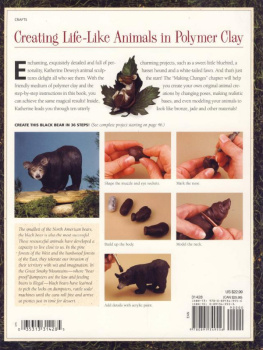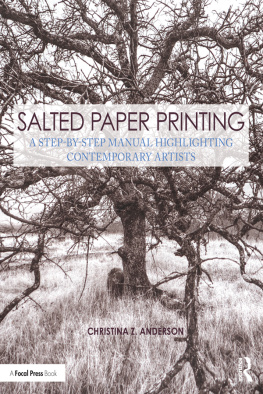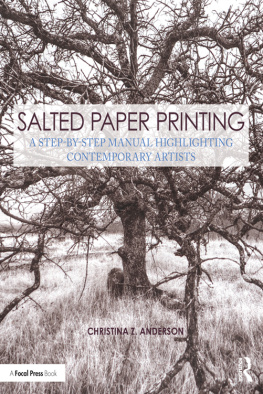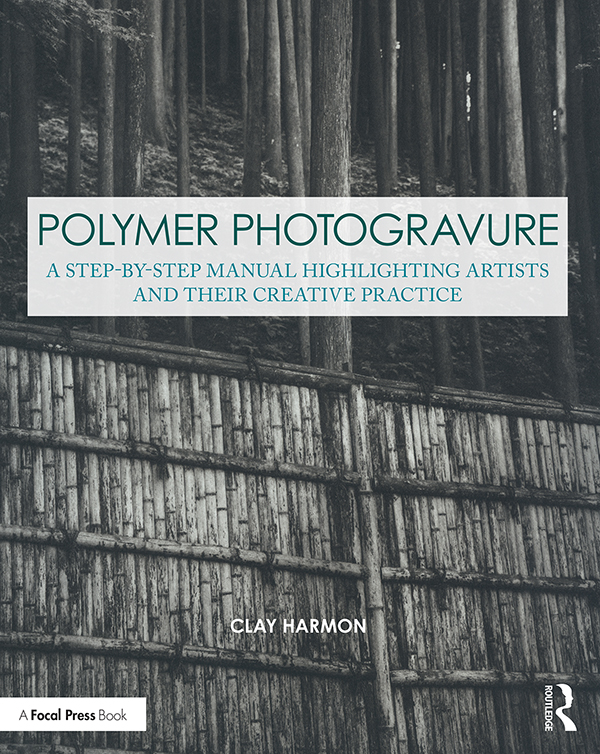Contents
POLYMER PHOTOGRAVURE
A Step-by-Step Manual, Highlighting Artists and Their Creative Practice
A Step-by-Step Manual Highlighting Artists and Their Creative Practice is a three-part book on the non-toxic process of making ink-on-paper intaglio prints from continuous-tone photographs using water-etched photopolymer plates.
Author Clay Harmon provides clear and easy-to-understand instructions that will enable anyone to successfully make a photogravure print. By quantifying the sensitometric behavior of polymer plates, Harmon has developed a methodical approach which will enable a new printmaker to produce plates in their own studio with a minimum of time and wasted materials.
Section One provides a straightforward guide to setting up the polymer photogravure studio. Section Two covers a step-by-step method of making the print from start to finish. Section Three showcases contemporary artists works, illustrating the variety and artistic breadth of contemporary polymer intaglio printmaking. The works in these pages range from monochrome to full color, and represent a variety of genres, including still lifes, portraits, nudes, landscapes, urban scapes, and more. Featuring over 30 artists and 200 full-color images, Polymer Photogravure is the most comprehensive overview of this printmaking process in print.
Key topics covered include:
Studio safety
Equipment and supplies, evaluated from both a cost and utility point of view
A brief discussion of the types of ink-based printing
Aquatint screen considerations
Image preparation and positive printing on inkjet printers
Paper preparation
A simple and efficient polymer plate calibration process that minimizes wasted time and materials
A straightforward inking, wiping, and printing method
Advanced printing techniques such as chine-coll, la poupe, and printing on wood
Troubleshooting guide to platemaking and printing problems
Tips on editioning and portfolios
A visual survey of the range of artistic expression practiced by contemporary artists
Sources for supplies and recommended reading
Polymer photogravure plates enable an artist to use an almost-infinite range of image color and papers to make a print. The finished prints are extremely archival, consisting of only ink and paper. With Harmons instructions, continuous-tone intaglio prints are within the reach of all.
Clay Harmons photographic work combines contemporary subject matter with historic photographic techniques. His interest is in the pushpull between the beautiful and the ugly often found in the urban landscape. Harmons work has shown nationally and internationally in over 30 shows and ten publications. He teaches workshops nationally in polymer photogravure and other historic photographic printing processes. To see his work, visit clayharmon.com
POLYMER PHOTOGRAVURE
A Step-by-Step Manual Highlighting Artists and Their Creative Practice
Clay Harmon

First published 2019
by Routledge
711 Third Avenue, New York, NY 10017
and by Routledge
2 Park Square, Milton Park, Abingdon, Oxon, OX14 4RN
Routledge is an imprint of the Taylor & Francis Group, an informa business
2019 Taylor & Francis
The right of Clay Harmon to be identified as author of this work has been asserted by him in accordance with sections 77 and 78 of the Copyright, Designs and Patents Act 1988.
All rights reserved. No part of this book may be reprinted or reproduced or utilised in any form or by any electronic, mechanical, or other means, now known or hereafter invented, including photocopying and recording, or in any information storage or retrieval system, without permission in writing from the publishers.
Trademark notice: Product or corporate names may be trademarks or registered trademarks, and are used only for identification and explanation without intent to infringe.
Library of Congress Cataloging-in-Publication Data
Names: Harmon, Clay, author.
Title: Polymer photogravure : a step-by-step manual highlighting artists and their creative practice / Clay Harmon.
Description: London ; New York : Routledge, 2019. | Series: Contemporary practices in alternative process photography series | Includes bibliographical references and index.
Identifiers: LCCN 2018024953| ISBN 9780815366010 (hardback : alk. paper) | ISBN 9780815366041 (pbk. : alk. paper) | ISBN 9781351259040 (e-book)
Subjects: LCSH: PhotogravureHandbooks, manuals, etc.
Classification: LCC TR980 .H37 2019 | DDC 770dc23
LC record available at https://lccn.loc.gov/2018024953
ISBN: 978-0-8153-6601-0 (hbk)
ISBN: 978-0-8153-6604-1 (pbk)
ISBN: 978-1-351-25904-0 (ebk)
Typeset in Adobe Caslon Pro and Century Gothic
by Florence Production Ltd, Stoodleigh, Devon, UK
Notice to readers:
Exercise caution in the handling of all photographic chemicals. Use of any such chemicals constitutes some risk, and some are poisonous. The publisher and author accept no responsibility for injury or loss arising from the procedures or materials described in this book whether used properly or improperly. The workplace should be well ventilated. Chemicals should be mixed only in the manner described. Avoid contact between the chemicals and eyes, skin, clothing, and furniture. Do not eat or drink while using chemicals. Keep them away from pets and children. Wear protective eyewear and gloves if necessary. In short, be mindful of all safety procedures for yourself and others.
Contents
Chapter 1
Introduction
Chapter 2
The Physical Studio: Materials and Equipment
Chapter 3
Digital Studio: The Virtual Workspace
Chapter 4
Making a Photogravure Print
Chapter 5
Making a Polymer Photogravure Plate
Chapter 6
Photogravure: Additional Techniques
Chapter 7
Troubleshooting
Chapter 8
Printing Portfolios and Editions
Chapter 9
Contemporary Polymer Photogravure Artists
Contemporary Practices in Alternative Process Photography Series
Series Editor: Christina Z. Anderson
The Contemporary Practices in Alternative Photographic Processes series focuses the lens on a variety of alternative, historical processes from the mediums 180-year history. Each book outlines a step-by-step approach to a particular medium, and features contemporary artists who use that particular process regularly in their practice. The richly illustrated books in this series serve as guidebooks for those new to alternative processes, refresher courses for professionals already familiar with each medium, and a source of inspiration for all.
Titles in the Series
Gum Printing: A Step-by-Step Manual Highlighting Artists and Their Creative Proctice,
Christina Z. Anderson
Salted Paper Printing: A Step-by-Step Manual Highlighting Contemporary Artists,
Christina Z. Anderson
The Handmade Silver Gelatin Emulsion Print: Creating Your Own Liquid Emulsions for Black & White Paper,
Denise Ross
When Christina Z. Anderson asked me if I would be interested in writing a book about polymer photogravure, I replied Sure! with about the same amount of thought that I normally give to a request to stop by the store to get a gallon of milk. I had already assembled a random assortment of writing through the years outlining my evolving approach to this photographic printing process that I used, both on an informational website and in the periodic workshops I would teach on the subject. I had been doing the process long enough that I was confident that I could convey at least my own approach to it.










